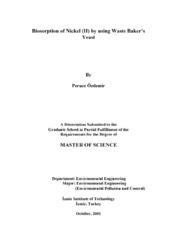Please use this identifier to cite or link to this item:
https://hdl.handle.net/11147/3757Full metadata record
| DC Field | Value | Language |
|---|---|---|
| dc.contributor.advisor | Harsa, Hayriye Şebnem | - |
| dc.contributor.author | Özdemir, Peruze | - |
| dc.date.accessioned | 2014-07-22T13:52:18Z | - |
| dc.date.available | 2014-07-22T13:52:18Z | - |
| dc.date.issued | 2001 | - |
| dc.identifier.uri | http://hdl.handle.net/11147/3757 | - |
| dc.description | Thesis (Master)--Izmir Institute of Technology, Environmental Engineering, Izmir, 2001 | en_US |
| dc.description | Includes bibliographical references (leaves: 63-68) | en_US |
| dc.description | Text in English;Abstract: Turkish and English | en_US |
| dc.description | xiii, 87 leaves | en_US |
| dc.description.abstract | 3 Biological methods for removing heavy metals are in competition with chemical and physical techniques such as precipitation, ion exchange, electrochemical treatment and evaporative recovery, especially, when the concentration of the heavy metal ion is low, between 1.0 and 100 mg/L. In order to qualify for industrial applications, biosorbents have to be produced at low cost. The use of biomass from various production stages; e.g. from the pharmaceutical or the food industries, is one way to minimize the costs. This study is concerned with the binding of nickel ions onto waste biomass of Saccharomyces cerevisiae genus, obtained from the food industry. Since the biomass employed is a waste material, biosorption process described in this study may represent a cheap alternative to conventional methods.Biomass cell walls, consisting mainly of polysaccharides, proteins and lipids, offer many functional groups which can bind metal ions such as carboxylate, hydroxyl, phosphate and amino groups.The objective of this study was to investigate the adsorption of nickel on wastebaker.s yeast as a function of several factors, i.e. pretreatment, pH, temperature, biomass concentrations and initial metal concentrations, in order to determine the optimum adsorption conditions of a batch process.Pretreatment of waste yeast biomass using sodium hydroxide, formaldehyde, nitric acid and ethanol decreased the sorption of nickel (II) ions compared with live biomass. Optimum initial pH for nickel (II) ions was 5.0 at the optimum temperature of 25o C. The uptake values increased with the increasing initial nickel (II) ion concentrations up to 150 mg/L. The optimum biomass concentration for this process was determined as 1.0 g/L.The biosorption isotherms were developed at various initial pH and temperature values. The equilibrium values were expressed with the Langmuir model while nickel sorption did not fit the Freundlich plot. The Langmuir parameters qmax (14.30 mg/L) and b (0.0069 L/mg) have been calculated."qmax" increased from 7.8 to 14.30 mg/L with the increase in pH from 3.0 to 5.0. Similar trend was observed for the "b" values; an increase from 0.0025 to 0.0069 L/mg were obtained when the pH of the solution was raised from 3.0 to 5.0. Both Langmuir model parameters were found to be the highest values at pH 5.0 which is consistent with the results of the optimization studies as described above.Temperature also affected the phase equilibria of nickel (II)/S.cerevisiae system.The highest capacity for biosorption system was obtained at 25o C with the qmax and b values of 14.3 mg/L and 0.0069 L/mg at pH 5.0, respectively. The enthalpy change for the biosorption process have been evaluated by using the Langmuir constant "b", which is related to the energy of adsorption. Nickel (II) biosorption is considered to be an exothermic process since low binding occurs when the temperature increases from 25 to 45o C.The uptake of nickel (II) ions by the yeast biomass was also investigated with respect to time under optimum operating conditions. Biosorption kinetics were rapid within the first few minutes. After the initial rapid uptake, further biosorption by yeast cells continued slowly and reached an equilibrium after 2 hours at all pH values of 3.0, 4.0 and 5.0. On the other hand, the rate of adsorption was found to be the fastest at pH 5.0 with an initial rate of around 3.59 mg Ni (II) / g-min. | en_US |
| dc.language.iso | en | en_US |
| dc.publisher | Izmir Institute of Technology | en_US |
| dc.rights | info:eu-repo/semantics/openAccess | en_US |
| dc.subject.lcc | TD755. O93 2001 | en |
| dc.subject.lcsh | Sevage--Purification--Biological treatment | en |
| dc.subject.lcsh | Heavy metals--Absorption and adsorption | en |
| dc.subject.lcsh | Metal ions--Absorption and adsorption | en |
| dc.subject.lcsh | Yeast | en |
| dc.title | Biosortion of Nickel (ii) by Using Waste Baker's Yeast | en_US |
| dc.type | Master Thesis | en_US |
| dc.institutionauthor | Özdemir, Peruze | - |
| dc.department | Thesis (Master)--İzmir Institute of Technology, Environmental Engineering | en_US |
| dc.relation.publicationcategory | Tez | en_US |
| dc.identifier.wosquality | N/A | - |
| dc.identifier.scopusquality | N/A | - |
| item.openairecristype | http://purl.org/coar/resource_type/c_18cf | - |
| item.languageiso639-1 | en | - |
| item.openairetype | Master Thesis | - |
| item.grantfulltext | open | - |
| item.fulltext | With Fulltext | - |
| item.cerifentitytype | Publications | - |
| Appears in Collections: | Master Degree / Yüksek Lisans Tezleri Sürdürülebilir Yeşil Kampüs Koleksiyonu / Sustainable Green Campus Collection | |
Files in This Item:
| File | Description | Size | Format | |
|---|---|---|---|---|
| T000017.pdf | MasterThesis | 591.89 kB | Adobe PDF |  View/Open |
CORE Recommender
Page view(s)
276
checked on Mar 31, 2025
Download(s)
64
checked on Mar 31, 2025
Google ScholarTM
Check
Items in GCRIS Repository are protected by copyright, with all rights reserved, unless otherwise indicated.